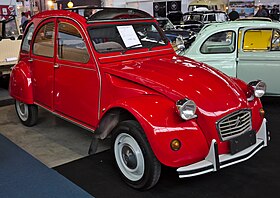I felt it was quite a brilliant design although Chris and Susan (our neighbours in Victoria and both Personal Injury lawyers) were horrified by the design and lack of safety...a friend of their's had one.
This image gives a pretty good idea of how the top worked.
Citroën 2CV
| Citroën 2CV | |
|---|---|
 | |
| Overview | |
| Manufacturer | Citroën |
| Production | 1948–1990[1] |
| Assembly | Levallois-Perret, France,[2] Forest/Vorst, Belgium Liège, Belgium Slough, UK Jeppener, Argentina (1960–1962), Buenos Aires, Argentina (1962–1980) Montevideo, Uruguay (Panel van & pick-up) Arica, Chile Mangualde, Portugal (1988–1990), Vigo, Spain (PSA Vigo Plant) Koper, Slovenia (former Yugoslavia) |
| Designer | André Lefèbvre Flaminio Bertoni Walter Becchia Marcel Chinon |
| Body and chassis | |
| Class | Economy car |
| Body style | 4-door saloon 2-door panel van 2-door pick-up 2-door coupé utility |
| Layout | Front engine, front-wheel drive / four-wheel drive |
| Related | Citroën Ami Citroën Dyane Citroën Acadiane Citroën FAF Citroën Méhari Citroën Bijou |
| Powertrain | |
| Engine | 375 cc H2 air-cooled 9 hp (7 kW). 425 cc H2 air-cooled 12 hp (9 kW). 435 cc H2 air-cooled 24 hp (18 kW). 602 cc H2 air-cooled 29 hp (22 kW). [3][page needed] |
| Transmission | 4-speed manual |
| Dimensions | |
| Wheelbase | 2.40 metres (94.5 in) |
| Length | 3.86 metres (152.0 in) |
| Width | 1.48 metres (58.3 in) |
| Height | 1.60 metres (63.0 in) |
| Curb weight | 600 kg (1,300 lb) |
| Chronology | |
| Successor | Citroën Dyane Citroën AX (indirectly) |
The Citroën 2CV (French: "deux chevaux" i.e. "deux chevaux-vapeur" (lit. "two steam horses", "two tax horsepower") is an air-cooled front-engine, front-wheel-drive economy car introduced at the 1948 Paris Mondial de l'Automobile and manufactured by Citroën for model years 1948–1990.[1]
Conceived by Citroën Vice-President Pierre Boulanger[4] to help motorise the large number of farmers still using horses and carts in 1930s France, the 2CV has a combination of innovative engineering and utilitarian, straightforward metal bodywork — initially corrugated for added strength without added weight.[5][6][7] The 2CV featured low cost, simplicity of overall maintenance, an easily serviced air-cooled engine (originally offering 9 hp), low fuel consumption, and an extremely long-travel suspension[8] offering a soft ride and light off-road capability. Often called "an umbrella on wheels",[9][10] the fixed-profile convertible bodywork featured a full-width, canvas, roll-back sunroof, which accommodated oversized loads and until 1955 reached almost to the car's rear bumper. Notably, Michelin introduced and first commercialised the radial tyre with the introduction of the 2CV.
Manufactured in France between 1948 and 1988 (and in Portugal from 1988 to 1990), more than 3.8 million 2CVs were produced, along with over 1.2 million small 2CV-based delivery vans known as fourgonnettes. Citroën ultimately offered several mechanically identical variants including the Ami (over 1.8 million); the Dyane (over 1.4 million); the Acadiane (over 250,000); and the Mehari (over 140,000). In total, Citroën manufactured almost 9 million 2CVs and variants.[11]
A 1953 technical review in Autocar described "the extraordinary ingenuity of this design, which is undoubtedly the most original since the Model T Ford".[12] In 2011, The Globe and Mail called it a "car like no other".[13] The motoring writer L. J. K. Setright described the 2CV as "the most intelligent application of minimalism ever to succeed as a car",[14] and a car of "remorseless rationality".[15]
